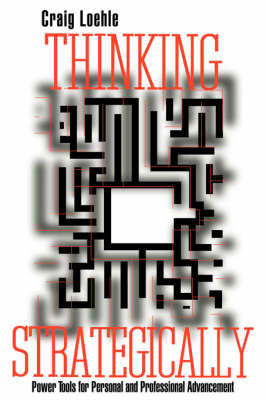
Thinking Strategically
Power Tools for Personal and Professional Advancement
Seiten
1996
Cambridge University Press (Verlag)
978-0-521-56058-0 (ISBN)
Cambridge University Press (Verlag)
978-0-521-56058-0 (ISBN)
Professionals today, whether scientists, engineers, entrepreneurs or managers, need to maximise their effectiveness. Hard work and motivation are not enough to tackle the complex real-world problems that surround us. Thinking Strategically provides the necessary power tools for dissecting complex problems and for creating innovative solutions.
Professionals today, whether scientists, engineers, entrepreneurs or managers, need to maximise their effectiveness. Hard work and motivation are not enough. Strategic thinking is needed to be able to choose the right problem to solve, to solve it in a cost-effective way, to use resources efficiently and to be innovative and productive. The combination of skill, motivation and the strategic use of effort can lead to astonishing levels of productivity. Real-world problems are complex and must be tackled with adequate conceptual tools. These tools are based on an understanding of the power of bottlenecks, paradox, scale and perspective constraints, and feedback as leverage points for getting to grips with the problem. Thinking Strategically provides the necessary power tools for dissecting complex problems and for creating innovative solutions.
Professionals today, whether scientists, engineers, entrepreneurs or managers, need to maximise their effectiveness. Hard work and motivation are not enough. Strategic thinking is needed to be able to choose the right problem to solve, to solve it in a cost-effective way, to use resources efficiently and to be innovative and productive. The combination of skill, motivation and the strategic use of effort can lead to astonishing levels of productivity. Real-world problems are complex and must be tackled with adequate conceptual tools. These tools are based on an understanding of the power of bottlenecks, paradox, scale and perspective constraints, and feedback as leverage points for getting to grips with the problem. Thinking Strategically provides the necessary power tools for dissecting complex problems and for creating innovative solutions.
Acknowledgements; Introduction; Part I. Component Skills of Strategic Thinking: 1. Strategic creativity; 2. Discovery as a process; 3. Strategic problem solving; 4. Reality check; 5. A matter of style; 6. Attitude: the inner strategist; 7. Strategic thinking exercises; Part 2. Strategic Thinking in Practice: 8. Problem finding; 9. Analysis: tools of thought; 10. Solutions: getting a grip; Summary: the strategic thinker; Literature cited; Index.
| Erscheint lt. Verlag | 28.8.1996 |
|---|---|
| Zusatzinfo | 2 Tables, unspecified; 34 Line drawings, unspecified |
| Verlagsort | Cambridge |
| Sprache | englisch |
| Maße | 157 x 236 mm |
| Gewicht | 420 g |
| Themenwelt | Geisteswissenschaften ► Philosophie ► Logik |
| Naturwissenschaften ► Biologie | |
| ISBN-10 | 0-521-56058-6 / 0521560586 |
| ISBN-13 | 978-0-521-56058-0 / 9780521560580 |
| Zustand | Neuware |
| Informationen gemäß Produktsicherheitsverordnung (GPSR) | |
| Haben Sie eine Frage zum Produkt? |
Mehr entdecken
aus dem Bereich
aus dem Bereich
Buch | Softcover (2023)
De Gruyter (Verlag)
CHF 34,90


